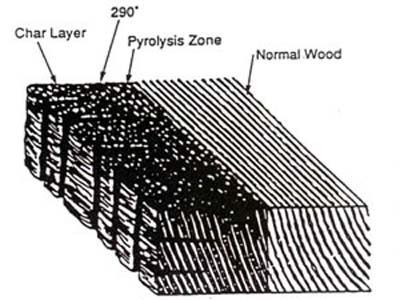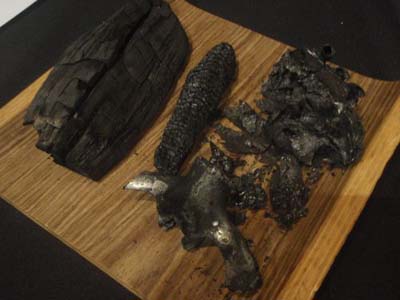PYROLYSIS & HOUSE FIRES
Pyrolysis & House Fires
- Pyrolysis Explained
-
You may not have heard about pyrolysis before, but it is extremely important that homeowners understand what it is and how to prevent it. Pyrolysis is a thermochemical decomposition of organic material at elevated temperatures. Basically, when you burn wood, the flame you are seeing is not from the combustion of the firewood itself, but from the gases released by its pyrolysis. Pyrolysis can decompose materials within reach simply with heat and oxygen and actually start a fire without direct contact to flame. “Auto ignition Temperature” is “the lowest temperature at which a combustible material ignited in air without a spark or flame.” (Ref, NFPA 921- 9, 3.3.13).
-
- Pyrolyzed in Wood
- Pyrolyzed wood slowly dries out, breaks down chemically, and can combust at a minimum temperature of 200°F compared to regular wood that burns at around 400°F. It can take a very long time for this chemical transformation to take place but there are no visible signs or changes to the wood when you look at.

- Why Pyrolysis occurring in your Home is Dangerous
- Pyrolysis occurring in the home is very dangerous because it sneaks up on the homeowner and can be completely shocking. The process can take years to decompose the wood in your home, but you have no idea it is happening. After the ignition point of your combustible material has been significantly reduced, it only takes a few cold nights, or uses of your wood burning stove to reach a minimum of 200°F and suddenly cause your framing to burst into flames and spread throughout your home. After it’s too late, many homeowners say, "but it has always been that way", which is why the danger is so real.
Exposed
wood (such as framing) that is too
close to your fireplace, wood
burning stove, or flue, is known to
be a serious safety hazard. The wood
is exposed to the heat your fire is
generating and that heat can be as
low as 200 degrees Fahrenheit to
chemically transform your wood
frame’s ignition point. Its ignition
point, also known as the combustion
point, will be lowered over time due
to the pyrolysis process and
eventually the wood can actually
catch fire without direct contact to
the flame! What’s even scarier
is that there are no visible changes
to the external appearance of the
framing as the process is occurring.
For example, thirty years could go
by with no issues, and then one
night you could be using your wood
burning stove and a fire suddenly
ignites on the wall close to the
heated exhaust pipe.

- How Pyrolysis can occur in/near your chimney or fireplace
- There are two main two reasons that pyrolysis occurs accidently in homes and starts house fires. The first is because your furnace, solid fuel stove, wood burning stove, or fireplace was installed incorrectly. The unit is too close to combustible materials such as wood trim, the edges of sheathing materials, or wood siding or flooring, and it is not code compliant. For example, a pre-fabricated fireplace that is installed directly on top of a wood subfloor without the required heat shielding baseplate is a risk. And the second reason is there is a crack or damage in your chimney liner or fireplace. Cracks allow heat and oxygen to escape and come into contact with combustible materials and heat and oxygen are all that is required for pyrolysis to occur. The National Fire Protection Association did a test where they placed a stack of 1/8 inch thick fiberboards close to a wood burning stove and it only took 4 days for the fiberboards to ignite without direct contact to flame. Using thermal-imaging, they were able to determine the ignition point was only at 228°F. Chimney connector pipes and boilers can reach as high as 1200°F so abiding by clearances and making sure you get a full inspection for cracks is essential.
- Combustible Clearance for Fireplaces and Chimneys
- The National Fire Protection Agency code 211, Table 9.5.1.1 provides the minimum clearances between combustible materials and a chimney connector or vent connector. You can see specifics in the picture in our photo gallery. Any appliance that produces a flame must have these proper distances and insulation from potentially combustible materials and the maximum requirement is 18 inches clearance to be on the safe side. If you have a prefabricated fireplace or other heating appliance, please also review the manufacturer’s safety requirements to ensure you are within code. Finally, chimney pipes should never be boxed in or enclosed, unless special approved vent materials are used in the process.
- Signs to look for Pyrolysis in your Wood Stove
- This is the scary part; there are no visible signs of pyrolysis! There is no way to test a piece of wood and determine what its current combustion point is without using heat. A trained professional knows to look out for the CAUSES of pyrolysis and recommend repairs before a fire occurs. They would certainly alert you if you heating appliance did not meet the NFPA’s clearance to combustible codes. Also, if you have any cracks or damage to your fireplace, chimney, chimney liner, or heating appliance, your chimney sweep will recommend repairs before lighting another fire. For further questions, please contact a chimney professional today.
